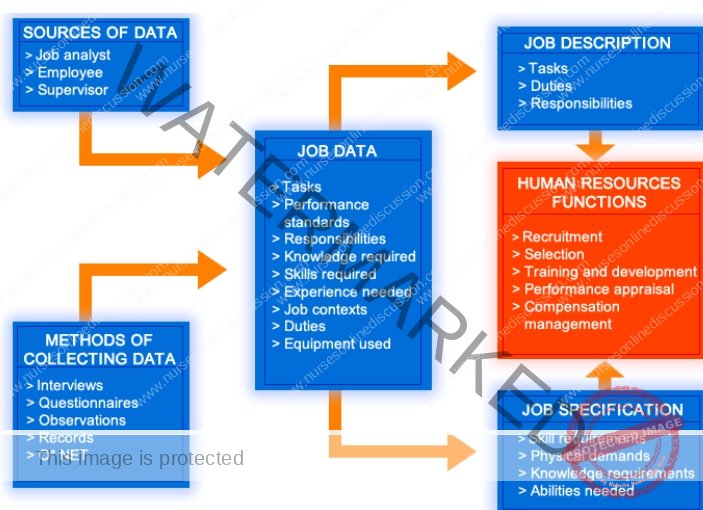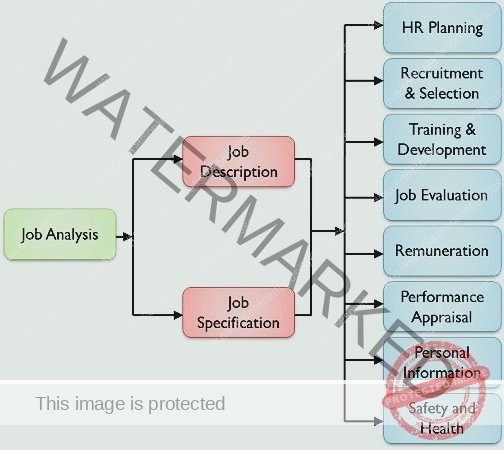Management
Subtopic:
Job analysis

Job analysis is the process of systematically gathering and examining details about a specific job.
In simpler terms: It’s about finding out exactly what a job involves by identifying the specific tasks, duties, and activities that make up the job.
This investigation includes understanding:
Duties & Tasks: What the job holder actually does on a day-to-day basis.
Skills & Knowledge: What the job holder needs to know and be able to do to perform effectively.
Abilities: The inherent capacities the job holder should possess to succeed.
The information gathered is crucial for creating:
Job Descriptions: Documents that outline the core components of a job, including responsibilities, tasks, authority, and duties.
Job Specifications: Documents that detail the required qualifications, skills, knowledge, and abilities needed to successfully perform the job.
Human Resource (HR) managers utilize job analysis data as a foundation for numerous HR functions like:
Recruitment: Identifying the right candidates.
Training: Developing effective employee training programs.
Performance Appraisals: Evaluating employee performance fairly.
Career Development: Planning employee career paths.
Ultimately, the main goal of job analysis is to boost organizational effectiveness and improve overall productivity.
When is Job Analysis Conducted?
Job analysis is typically carried out in several key situations:
New Organizations: In start-up organizations, job analysis is essential to define all the necessary roles needed to achieve organizational goals from the outset.
Creation of New Jobs: When an existing organization introduces a new position, job analysis is vital for defining the responsibilities, required skills, and qualifications for this new role.
Significant Job Changes: If a job’s nature changes substantially due to new technologies, workflows, or systems, job analysis is necessary to update the job description and specifications to reflect the revised role.
Wage and Salary Structure Design: Before implementing or revising compensation plans, job analysis is used to evaluate different jobs and determine their relative worth to ensure fair pay structures.
Addressing Job Inequities: When employees or management perceive imbalances between job demands and compensation, job analysis can help identify and rectify these perceived inequities by providing objective data about job roles and requirements.
Common Job Analysis Techniques:
Questionnaires: Using structured sets of questions to gather job-related information directly from employees or subject matter experts. Think: Surveys distributed to employees about their tasks and responsibilities.
Checklists: Employing predefined lists of job duties, tasks, and responsibilities, which are then reviewed and either checked off or rated for relevance by employees or experts. Think: A pre-made list of tasks where respondents mark which tasks are part of the job.
Individual Interviews: Conducting one-on-one discussions with job incumbents or experts to obtain in-depth information about job duties and requirements. Think: A direct conversation with an employee to understand their daily tasks.
Observation: Directly observing employees performing their job tasks to understand the physical demands, working conditions, and interactions involved in the job. Think: Watching someone do their job to understand the work environment and tasks.
Group Interviews: Facilitating discussions with groups of employees or experts to collect diverse perspectives and comprehensive information about a job. Think: A panel interview with multiple employees to get a broader picture of the job.
Technical Conferences: Holding meetings with industry or subject matter specialists to gather expert insights into the technical aspects, industry trends, and future developments relevant to a job. Think: Consulting with industry professionals to understand the technical aspects of the role.
Diaries/Self-Reports: Having employees maintain a written log of their daily activities, tasks, and responsibilities over a period of time. Think: Employees keep a journal detailing their work throughout the day.
Critical Incident Technique: Documenting specific examples of significant events or situations that occur on the job, which highlight key job tasks and effective or ineffective behaviors. Think: Collecting stories of specific job events that show important job aspects.
Document Review: Examining existing organizational documents, such as previous job descriptions, performance reviews, and training materials, to extract relevant job information. Think: Looking at existing job descriptions and training manuals for job insights.

The Process of Job Analysis
Job analysis is a structured procedure broken down into distinct phases to effectively understand job roles. These steps are sequential, building upon each other to create comprehensive job profiles.
Step 1: Data Collection – Gathering Job Information
This initial phase is about systematically collecting the necessary information to understand the job thoroughly.
Identify Data Sources: Determine the best sources of information. These might include:
Jobholders (Incumbents): Individuals currently performing the job. Think: Employees in the role.
Supervisors: Those directly overseeing the job role. Think: Managers of the employees in the role.
Subject Matter Experts (SMEs): Individuals with deep knowledge about the job or industry. Think: Experienced professionals or consultants.
Existing Documentation: Relevant materials like company manuals or past job descriptions. Think: Company records about the job.
Select Data Collection Methods: Choose appropriate techniques for gathering information. Common methods involve:
Interviews: Conducting structured or semi-structured conversations. Think: Asking questions directly in a conversation.
Questionnaires: Using written surveys with targeted questions. Think: Distributing forms with questions about the job.
Observations: Directly watching employees perform job tasks. Think: Observing employees at work.
Document Review: Examining pre-existing records and materials related to the job. Think: Studying existing job descriptions.
Step 2: Job Data – Compiling and Analyzing Information
This phase focuses on organizing and making sense of the raw data collected in Step 1.
Compile Collected Data: Organize all the information gathered from various sources and methods into a structured format. Think: Putting all the survey responses and interview notes together.
Analyze Job Data: Examine the compiled data to extract essential job-related insights. Identify:
Tasks: Specific activities performed in the job. Think: Day-to-day work actions.
Responsibilities: Key accountabilities and duties of the role. Think: Major areas of job ownership.
Required Knowledge: Information and understanding needed to perform the job. Think: Facts and concepts needed for the role.
Necessary Skills: Proficiencies and abilities to execute job tasks effectively. Think: Practical abilities and proficiencies for the job.
Essential Abilities: Inherent capacities and traits needed for job success. Think: Natural talents and aptitudes helpful in the role.
Step 3: Job Description – Defining the Job Role
This step involves creating a formal document that summarizes the core elements of the job based on the analyzed data.
Create Job Description Document: Develop a written job description using the insights from the analyzed job data. This document should clearly outline:
Job Purpose: The overall reason for the job’s existence and its contribution to the organization. Think: The ‘why’ of the job.
Essential Functions: The primary and fundamental duties of the job. Think: Core tasks and responsibilities.
Key Responsibilities: Major duties and accountabilities assigned to the role. Think: Important duties the job holder is accountable for.
Reporting Relationships: The position’s place in the organizational hierarchy, who the job holder reports to, and who reports to them (if anyone). Think: The job’s position within the company structure.
(Note: Arrows from ‘Job Data’ to ‘Job Description’ visually indicate that the job description is derived directly from and based upon the Job Data.)
Step 4: Job Specifications – Defining Required Qualifications
This step focuses on outlining the necessary qualifications and attributes for an ideal candidate to succeed in the job, also drawing from the analyzed job data.
Develop Job Specifications Document: Based on the job data, create job specifications, which detail:
Required Qualifications: Formal education, certifications, licenses, and training needed. Think: Formal credentials and education.
Necessary Experience: Type and amount of previous work experience beneficial or essential for the role. Think: Relevant work history.
Other Desirable Attributes: Personal traits, soft skills, or specific competencies beneficial for successful job performance. Think: Personality traits and soft skills suited for the role.
(Note: Arrows from ‘Job Data’ to ‘Job Specifications’ visually indicate that job specifications are also derived directly from and based upon the Job Data.)
Step 5: Human Resource Functions – Applying Job Analysis Outcomes
This final step emphasizes the practical application of job descriptions and specifications across various HR functions.
Utilize for HR Activities: Apply the job descriptions and specifications as foundational tools to guide and enhance various core HR functions. These functions include, but are not limited to:
Recruitment: Defining candidate requirements for job postings and sourcing strategies. Think: Using job specs to find the right applicants.
Selection: Developing interview questions and assessment criteria aligned with job requirements. Think: Choosing candidates based on job specs.
Training: Identifying training needs based on job duties and required skills, designing relevant training programs. Think: Training employees on skills required by the job description.
Performance Management: Establishing performance standards and evaluation metrics that reflect job responsibilities and expectations. Think: Evaluating employee performance based on job description tasks.
Compensation: Determining fair and competitive salary ranges based on job duties, required skills, and responsibilities outlined in the job description and specifications. Think: Setting pay based on job responsibilities defined in the job description.
(Note: Arrows from ‘Job Description’ and ‘Job Specifications’ to ‘Human Resource Functions’ visually indicate that these documents serve as guiding tools for these HR activities.)

Benefits of Job Analysis to HRM Functions
Job analysis is a powerful tool that significantly enhances the effectiveness of Human Resource Management (HRM) across a wide spectrum of activities, from initial workforce planning to ensuring employee well-being and career advancement. The detailed insights gained from job analysis are instrumental in supporting numerous core HR functions, as outlined below:
Strategic HR Planning:
Benefit: Job analysis is crucial for forecasting future workforce needs. It allows organizations to understand the number and types of roles required to meet upcoming demands.
Explanation: By detailing job requirements, job analysis informs HR planning regarding necessary staffing levels, skill sets, and anticipated adjustments needed due to technological advancements or shifts in business strategy. This proactive approach ensures the right people are in place when needed.
Recruitment:
Benefit: Job analysis is key to attracting and engaging potential candidates. Clearly defined job requirements make job openings more appealing to suitable applicants.
Explanation: Providing clear information about job duties, responsibilities, and necessary qualifications – derived from job analysis – allows for the creation of targeted recruitment messages that resonate with the right talent pool, increasing the quality of applicants.
Selection:
Benefit: Job analysis is fundamental for selecting the most qualified individuals to fill open positions.
Explanation: By pinpointing the essential knowledge, skills, abilities, and personal characteristics (KSAOs) needed for successful job performance, job analysis enables the development of effective selection criteria and assessment methods to identify top candidates.
Training and Development:
Benefit: Job analysis is invaluable for designing and delivering effective employee development programs. It pinpoints specific skill and knowledge gaps.
Explanation: Identifying the specific skills and knowledge required for different jobs, through job analysis, allows HR to create focused training initiatives. This ensures training is relevant, targeted, and addresses the actual needs of employees in their roles, enhancing performance and organizational capability. Job analysis also pinpoints employees needing specific upskilling.
Job Evaluation:
Benefit: Job analysis underpins fair job evaluation and compensation structures. It provides the necessary data to determine the relative worth of different roles within an organization.
Explanation: The detailed job information obtained from job analysis is used to systematically assess and compare different jobs. This comparative evaluation allows for the establishment of appropriate pay scales and salary differences that accurately reflect the value and complexity of each role, promoting internal pay equity.
Performance Appraisal:
Benefit: Job analysis facilitates objective and effective performance reviews. It establishes clear performance benchmarks for each job role.
Explanation: By defining specific job duties and responsibilities, job analysis enables the creation of clear and measurable performance standards. Managers can then use these standards to fairly evaluate employee performance, providing constructive feedback focused on actual job expectations and areas for development.
Wage and Salary Administration:
Benefit: Job analysis informs equitable and justifiable compensation decisions. It highlights the skill requirements and inherent job factors like risks.
Explanation: Job analysis provides crucial insights into the qualifications needed for particular jobs, as well as any associated risks or challenging aspects. This information helps in setting appropriate compensation levels that are fair, competitive, and reflective of both the required skills and the nature of the work.
Safety and Health:
Benefit: Job analysis plays a role in identifying and mitigating workplace hazards. It helps in pinpointing unsafe conditions and unhealthy aspects of the work environment.
Explanation: Through job analysis, potentially hazardous tasks, equipment, or environmental factors are identified. This allows organizations to proactively develop and implement targeted safety and health protocols, procedures, and preventative measures to minimize workplace accidents and promote employee well-being.
Career Planning:
Benefit: Job analysis enhances employee career pathing and development. It provides clarity on potential growth opportunities within the organization.
Explanation: By offering a comprehensive understanding of different job roles, job analysis helps employees and managers identify logical career progression routes and skill development needs. This transparency empowers individuals to make informed decisions about their career paths, and allows organizations to strategically plan for employee advancement and talent pipeline management.
Get in Touch
(+256) 790 036 252
(+256) 748 324 644
Info@nursesonlinediscussion.com
Kampala ,Uganda
© 2025 Nurses online discussion. All Rights Reserved Design & Developed by Opensigma.co

